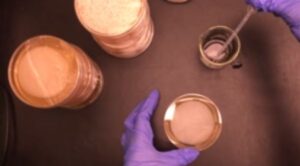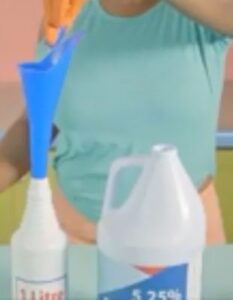Disinfection is a commonly used process to kill harmful bacteria, viruses, and other microorganisms that contaminate well water. Disinfection is easy but technical work. To achieve proper results, you must take care of certain things.
There are two types of disinfection procedures usually used to kill bacteria in well water.
Shock Chlorination – It is a one-time process and is often carried out after a well has been drilled, modified, repaired, or you detect a change in taste, smell, and appearance of the water. Shock chlorination is the most basic and preliminary step used to improve water quality.
Continuous Chlorination – It is used to ensure that your water is regularly chlorinated to kill bacteria. While shock chlorination is physically carried out, continuous chlorination is an automated process and is done with feed injectors.
In this article, we are going to discuss everything you need to know about shock chlorination. We will explain in detail how to calculate the volume of water and how much chlorine you need. This shock chlorination guide will also explain that how your well gets contaminated, how to test water, and how to interpret the results.
How can a Water Well get bacteriologically contaminated?
Bacterial contamination can occur due to the following reasons.
- Your well is located too close to a source of contamination, and the length of the well casing is small.
- The construction process was carried out with poor sanitary conditions, and the equipment was not disinfected.
- Wells having poor grouting, unsealed covers allow bacteria to enter the water.
- Improperly sealed and small casing above the ground allows surface water to enter the well. Surface water is contaminated with bacteria.
- Corroded and old well casing allows bacteria to seep into the well.
- The aquifer is highly fractured, or the gravel deposit is not filtering the water properly to remove bacteria from it.
- There are problems with the well cap. It may not be properly installed or loose, allowing small animals and insects to enter the well. Insects carry bacteria on their backs.
- A cross-connection between the plumbing system and the sewage/septic system allows bacteria to enter the well.
Testing for Bacteria

EPA and nearly all state laws recommend that all private wells must be tested annually for bacteria. A water test must also be conducted after a well has been built, modified, or relocated. You must also test your water when you notice a change in smell, appearance, or taste. The best time for testing well water for bacteria is early spring or late summer. These are the times when well water is unsafe due to snowmelt or floods/heavy rainfalls.
You must hire the services of a certified lab to get the water tested. Please avoid home testing strips as they are not reliable. Once you have the test results in your hand, interpret them. If the bacteria are not found, the water is safe to drink. For results with bacteria found, immediately stop using well water for drinking and cooking purposes. You can use bottled water or boiled water (at least one-minute rolling boil) until you fix the bacteria problem in your well.
When should you use Shock Chlorination?
All well owners must shock chlorinate their well in the following cases.
- When a new well is built or an existing well is repaired, or an old well is brought into service.
- The test results are positive for bacteria.
- Floodwater surrounds the well.
- The water gets cloudy, muddy, or orange after rain.
- Well water shows symptoms of the presence of iron bacteria.
Shock Chlorination
Safety Measures
Before we begin, it is important to take safety measures first. The following tips will help you ensure that nothing will go bad during the process.
Electrical
- Turn off the power to the pump and switch off the circuit breaker.
- Wear rubber gloves and rubber sealed footwear to avoid electrocution.
- Remove the well cap after turning off the power to the well pump. Inspect the electrical connections and cable for any damages or hazards. Get them repaired or replaced before starting to work.
- Make sure that electrical power to the water pump is turned off during the entire process.
Chemical
- When handling a chlorine-based product, you must wear safety goggles or a face shield.
- Don’t mix chlorine and ammonia products.
- Avoid using chlorine products in enclosed spaces. If your well is located in a pit, alcove, or basement, hire a professional to chlorinate the well for you. If you want to do it yourself, you must use a professional respirator.
- Always use the chlorine according to the volume of water. More chlorine will take more time to clear out.
- Never drink heavily chlorinated water. Avoid using it for showering or swimming as well.
- Keep chlorine-based products out of reach of children.
The Procedure
First of all, clean all the tree debris from near the well cap and storage tank. The following steps will help you complete the chlorination process.
Bypass the Water Treatment Devices – Almost all private well systems have a water treatment device for softening or improving the water quality. You must bypass all these devices before beginning the chlorination process. A high amount of chlorine in water can damage the filtration media in water filters. However, you must also disinfect these devices individually to get the best results. It is possible that bacteria have a colony in your water filter.
Calculate the Volume of Water – Next up is to calculate the volume of water in your well. It can be calculated using a simple formula, but you need to know the following measurements to get the accurate volume of water in your well.
Total Well Depth: It is the total depth of the well. You can get this measurement by accessing your well records. If you don’t have the records with you, contact your state’s well management department.
Static Water Level: Static water level is the undisturbed water level in the well. When a well has not been pumped for at least 6-8 hours, the water level in it is known as static water level. You can read more about it here.
Volume Factor: Volume factor is based on the well diameter; the larger the diameter, the greater the volume factor. While depth and static water levels are different for every well, the volume factor is almost the same. You can use the following information to get a volume factor.
- 2-inch diameter = ¾ quart water for each foot of water standing in the well.
- 4-inch diameter = ½ gallon water for each foot of water standing in the well.
- 5-inch diameter = 1-gallon water for each foot of water standing in the well.
- 6-inch diameter = 1½ gallons water for each foot of water standing in the well.
- 8-inch diameter = 2½ gallons water for each foot of water standing in the well.
- 10-inch diameter = 4 gallons water for each foot of water standing in the well.
Suppose that you have a well with an 80-meter depth and a static water level of 15 feet. The diameter is 6-inches, and the volume factor is 1.5 gallons. The total volume of water can be calculated using the following formula.
Volume Factor x (Total well depth – Depth to the static water level)
= 1.5 x (80-15)
= 97.5 gallons
The above volume calculated is the standing volume of water in the well. The standing volume may change with time or due to environmental factors and/or your usage patterns.
Arrange Water for Mixing Bleach – After calculating the volume of water in the well, you need to arrange the same volume of uncontaminated water. You can use clean new trash cans or disinfected containers for putting the water. If you hire a professional, you will save yourself from all these hassles.
Calculate the Volume of Bleach – The next important thing is to calculate the amount of bleach you need. Sodium hypochlorite is recommended to be used for disinfection. A concentration of 100-300 parts per million (PPM) of chlorine is good for private well systems. If the bacterial infection is very severe, you may need to use a strongly acidic solution or clean the well through mechanical ways. Make sure the bleach you are using is free from additives. It must not contain any scents, algaecides, or thickening agents. Such additives reduce the effectiveness of the disinfection process. The following table illustrates the volume of chlorine needed with respect to the concentration.
| The volume of Bleach to be added in 100 gallons of water | Chlorine Concentration in PPM |
| 3/4 Quarts | 100 |
| 1.5 Quarts | 200 |
| 2 Quarts | 300 |
You can double the bleach volume with the same concentration if you are using 200 gallons of water. Similarly, if your well is smaller and holds less water, reduce the volume of chlorine accordingly.

Preparing the Solution – Once you have calculated the water and chlorine volume, and arranged the water for mixing the chlorine, prepare the disinfection solution. It is best to keep the containers nearby so that you don’t have to carry them near the well. Remember to wear a face mask while working with chlorine. We don’t want you to inhale the pungent chlorine fumes.
Adding Chlorine Granules – You need to add about half a cup of chlorine granules to the well. You must use the chlorine granules or tablets which are approved by your local health office. Most states recommend using calcium hypochlorite. The granules are needed to decontaminate the column of water in the well prevent bacteria from coming out of the aquifer when you add the liquid chlorine. You must never use liquid chlorine or tablet-based chlorine products if your well is facing arsenic contamination.
Pouring in the Chlorine Solution – The next and the most important step is to pour the chlorine solution. Make sure that you are following all the safety measures mentioned above. You must add all the chlorine solution on one go. If you add in intervals, the effectiveness can reduce. Pouring in one go will increase the pressure and help reach the chlorine solution to the bottom of the well.
Rinsing the Inside Surface – Now, you have to connect the water pipe to a nearby faucet and turn the water pump on. Make sure that all the other faucets in your home are closed before starting the chlorination process. Turn on the water pump and turn on the water. This recirculation will help you wash away the entire surface of the well to remove bacteria clinging to the well casing.
Drain the Water Tank and Water Heater – After recirculating the chlorinated water, drain the water tank and water heater. It will waste the already-stored water in these tanks to be replaced with chlorinated water. Make sure you turn off the water pump before doing this step.
Refilling the Water Tank and Water Heater – Once you have drained the water tank and heater, refill them again by turning on the water pump.
Read more: How Long Does it take for a Water Well to Refill?
Running Chlorine Water – Open every tap connected to your water system. Don’t leave any tap turned off. Wait for the chlorinated water to reach all the taps. Wait for chlorine smell. Once you smell chlorine, turn off all the taps. If you have cartridge-based water filters connected to your plumbing system, replace the cartridges after you are done with the chlorination process.
Let Chlorine do its Work – Now keep all the taps closed for at least 24 hours. Some people suggest that 12 hours are also enough, but it is better to wait for at least 24 hours so that chlorine can do its work.
Flushing the Water – It is now time to flush the chlorinated water from your taps. Open all the taps in your home. Begin from the one closest to the well. Ensure that you do not draw water from below the pump intake level. If there is a pressure tank attached to the plumbing system, keep the pressure at 30 PSI. Ensure that chlorinate solution does not get into lakes, rivers, water streams, lawns, and landscapes. Take special care and not to let the chlorinated water enter the septic system. You may end up killing the decomposing bacteria there. The time required for the flushing process depends upon the concentration of chlorine used and the volume of the solution.
Retesting – It is best to get your water retested after a week. A retesting will ensure that the shock chlorination has worked, and all the bacteria in your well have been killed. If the bacteria still appear in the water, you may need a continuous chlorination method or may have to relocate your well.
How long does it take for Water to Clear after Shocking a Well?
Many people are worried about how much time they will have to wait after shocking their well so that they can start drinking it. It is best to wait for at least one week before you start drinking water from a shocking well. You must get your water retested. The smell and taste of chlorine will clear in 2-3 days after chlorination.
Some Important Things to Consider during the Chlorination Process
- Check the expiry date of the chlorine products before using them. Don’t use a chlorine product with a pH greater than 7.5. It is usually mentioned on the product packing. If not, you can check it with a simple litmus test.
- If you are hesitant or think that you may not follow all the safety protocols, contact a licensed well driller and let him chlorinate the well for you.
- You must get your well tested again after a week.
- Unless your well has a repetitive bacteria problem, do not chlorinate your water again until the bacteria are detected in it.
- Don’t add more bleach to get better results. It will increase the pH of your well water and alter the natural taste.
- Never use chlorine in wells that are at risk from arsenic contamination.
What to do if Bacteria reoccur in my Well?
Bacteria may reoccur in your well after shock chlorination. Such an event indicates a bigger problem at hand. Continuous chlorination is the best strategy to deal with such problems. The reoccurrence of bacteria can happen due to the following reasons.
- A malfunctioning septic system within 50 feet of your well.
- A pathway for surface water contamination due to faulty well design, wrong construction, leaked or damaged well cap or casing, and less grouting.
Final Words
Bacterial problems are common in wells across the U.S. To avoid such issues, you must build your well according to the state laws, hire the services of only licensed professionals, and only use approved materials. Try to give special attention to drilling site selection as 90% of bacterial contamination results from improper well construction.
